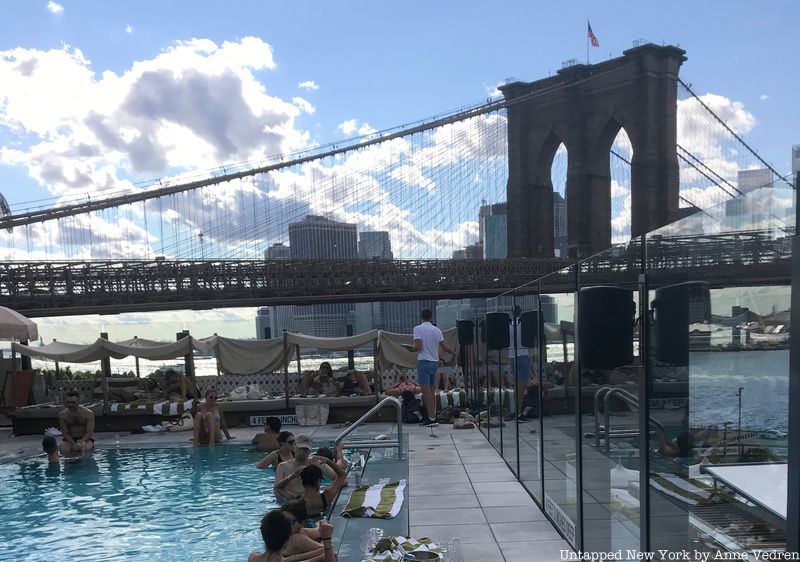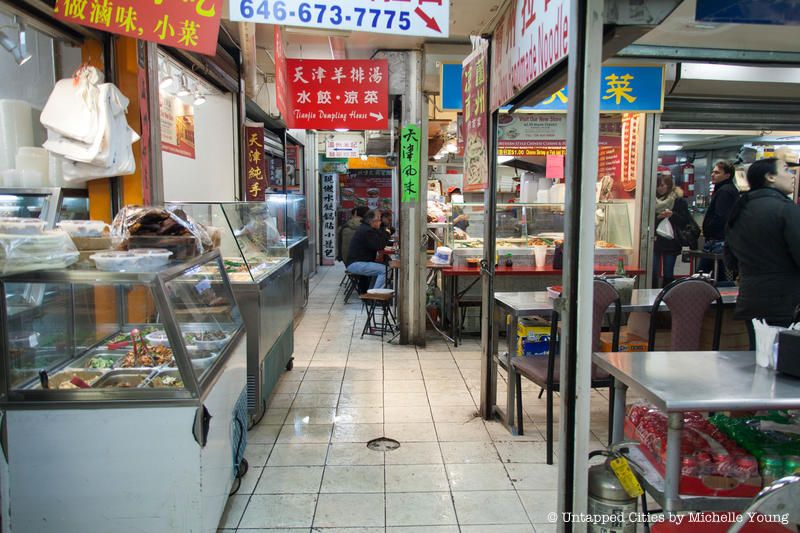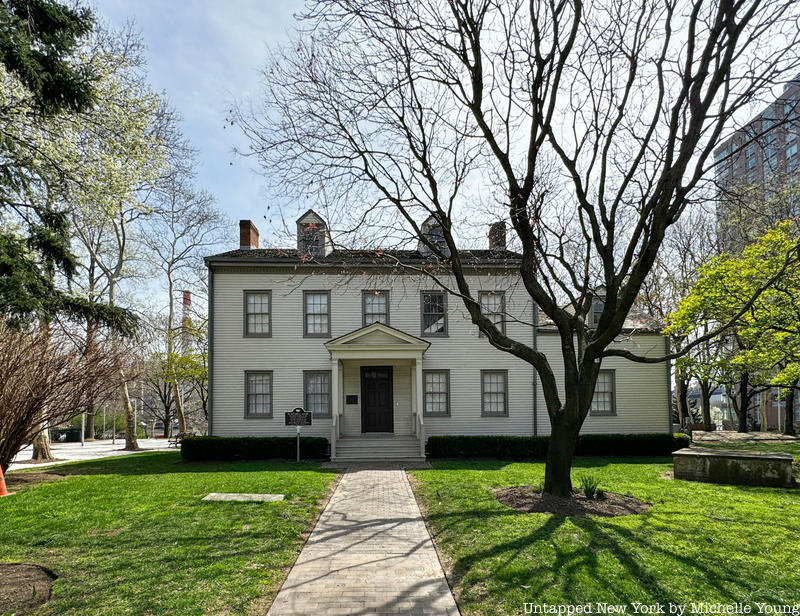Last Chance to Catch NYC's Holiday Notalgia Train
We met the voices of the NYC subway on our nostalgia ride this weekend!

A New York, New York address with a zip code starting with 100 mean it’s not in Brooklyn, not in Queens, not in the Bronx, and not on Staten Island but in Manhattan.

I was surprised by something recently. We received an order for a copy of my book Secret Brooklyn through our online shop and the shipping address was to a Main Street in New York, New York. Hold up—is there a Main Street in Manhattan that I never knew about? A New York, New York address with a zip code starting with 1-0-0 means it’s not in Brooklyn, not in Queens, not in the Bronx, and not on Staten Island. But that leaves…Manhattan?
I quickly plugged it into Google Maps, of course. Some of you may already know where it is, and if so kudos! (Listen to our latest podcast episode to discover where it is and follow with our visual guide below!) My next thought was, is there more than one Main Street in New York City? Most people probably associate the idea of Main Street with quaint American towns and villages but New York City actually has not just one but five Main Streets. So what’s a girl to do with this information?…Go to all the Main Streets in the city, or course!
Our newest episode of the Untapped New York podcast will take you across all five boroughs of New York City, from a well-trod tourist destination to the terminus of the Staten Island Railway, to a little-known bungalow community in the Bronx, and more. In each location, I check out what to eat and see, and at one of the Main Streets in particular, I share my memories of going there frequently as a child. My co-host, Justin Rivers, Untapped New York’s Chief Experience Officer, also joined me at another Main Street to share his expert knowledge. Below is a visual guide to our exploration of New York City’s Main Streets to accompany the podcast.







Main Street on Staten Island is curiously not in the most populated area of the borough but in Tottenville, on the southeastern tip. If you’re wondering how remote it is, the street begins at the terminus of the Staten Island Railway. I arrived just as a tanker was making its way around this bend of the Arthur Kill, one of the last remaining undiscovered waterfronts in the city.
Large tankers could only come through here as of 2017, when a huge retrofit of the Bayonne Bridge was done to raise the roadbed. Since then we’ve had a series of record-breaking large cargo vessels arrive, which includes the Marco Polo, the largest container ship in the world. It’s the length of the Empire State Building. Main Street runs through the entire width of the island north-south but its commercial core is only about two blocks long, close to the rail station.
I figured a good starting point for my exploration was logically the Main Street Coffee shop, next to the intersection of Craig Avenue. It’s in an adorable white clapboard house with a Victorian gable and bay windows that dates to 1892. There’s even a white picket fence outside. Techno music seems to be the music of choice, if that’s your thing. This location is super cozy with a copper wraparound counter, a lot of subway tile, and copper Edison light bulbs hanging from the ceiling. I had a delicious açai bowl with fresh fruits and coconut flakes and a hot chocolate, before checking out what else is on Main Street.
Just a few feet away, at the intersection of Main Street and Craig Avenue there are two very stately buildings that have seen better days. One is the Tottenville National Bank with its tall ionic columns and a carved eagle in its pediment, but with some of its windows boarded up. Diagonally across the way is the former Richmond County Federal Savings Bank, now the Virgin Mary & St. George Coptic Orthodox Church.
As you walk closer to Amboy Road the business get even more dense, and you’ll find the post office, barbershop, laundry, a taqueria, a few delis, pet shop, a discount store, even a tropical fish store and a masonic lodge. Something that caught my eye that’s not on the map, is a vintage sidewalk clock. A lot of the sidewalk clocks in New York City are landmarked but not this one. It was actually installed more recently as a memorial to 9/11.
You can learn more about the history of Tottenville in our upcoming virtual talk with Angie Mangino, a longtime Tottenville resident and author of 17th Century Tottenvile History Comes Alive, on April 17th! This talk is free for Untapped New York Insiders. Not an Insider yet? Become a member today and use code JOINUS for your first month free.





Main Street in Brooklyn is a short two-block belgian block stretch in Dumbo that starts behind Pebble Beach at the eastern end of Empire Stores, a former coffee storehouse now filled with modern shops, businesses, and offices, including Dumbo House—a branch of Soho House that has a rooftop pool here with stunning views of the Brooklyn Bridge. I was lucky to document Empire Stores when it was in renovation with the architect Navid Maqami when it was in renovation. Maqami was a gracious host, very passionate about his work, which included Dock 72 in the Brooklyn Navy Yard and 250 Water Street also in Dumbo. He passed away in 2019 leaving my lovely visit with him just a memory now.
The Dumbo we know today is the handiwork of the Walentas brothers and their real estate company Two Trees. If you look up at the foot of Main Street, the Clocktower Condominium at #1 Main Street now bears the name the Walentas Building. I suppose it’s only appropriate that Main Street in Brooklyn begins with a nineteenth-century coffee storehouse and ends with a Starbucks.



The Flushing portion of Main Street might be the most famous of all the New York City Main Streets. Queens’ Main Street is also the longest, at nearly four miles long. I also happen to know it quite well, because I spent a lot of time here as a kid. I’m a second-generation Taiwanese-American and I attended many a banquet where we stuffed our faces with food. Taiwanese people talk about food all the time, what we had for breakfast, what we are going to have for lunch, and what our plans are for dinner. It’s the most food-obsessed culture I have ever come across and the most telling thing is one of the Taiwanese ways to say hello. It’s “jia bah bueh,” which means, “Did you eat yet?”
I did a lot of other stuff in Flushing too, on and around Main Street, like buying groceries, getting many of those coveted Manhattan Portage bags which every proper Asian-American carried at the time, Sanrio stuff like Hello Kitty and Keroppi the frog, and other things you could otherwise only get in Asia. In graduate school, I spent a lot of time in the Golden Mall before it was demolished and rebuilt, making a video of that idiosyncratic underground food mall with some of the most amazing foods in New York City. Xi-An Famous Foods started there and Anthony Bourdain put the Golden Mall in the national consciousness.
On a visit to Flushing Main Street today, I would recommend visiting New World Mall. This is the closest you’ll get to what vertical shopping in Asia feels like, with lots of shops, a food court, and a grocery store inside. Xi-An Famous Foods is still on Main Street as well, just down the street.







My next Main Street expedition was to the Bronx. Main Street there is a short five-block stretch in the neighborhood of Edgewater Park, a waterfront bungalow community where I watched some maintenance folks zip around in a golf cart. Edgewater Park is one of those neighborhoods that transport you out of New York City. The Main Street here does not have any commercial activity but it has a charm of its own. One end of Main Street begins at the waterfront, where a boardwalk wraps around the peninsula with great views of Throgs Neck Bridge and Long Island. A jetty extends down into the water and a flagpole with an American flag clangs in the wind. Speaking of American flags, Edgewater Park is full of them, along with Irish flags. All in all, this main street was a pleasant discovery full of chirping birds and seaside breezes.
One thing people often forget about the Bronx is that there were a good number of Gilded Age mansions up here. Edgewater Park also had one, built by George Townsend Adee who apparently was quite the sportsman, in addition to being an Army veteran of WWI and the Spanish-American War. He was quarterback of the Yale Bulldogs football team, undefeated in 1894, and the first team quarterback of the All-American college football team. He was also an amateur tennis player, but good enough to compete in the US singles championship for six years, served as president of the US Lawn Tennis Association, and inducted into the International Tennis Hall of Fame.










Finally, our last Main Street is on Roosevelt Island, which spurred this whole exploration. The best way to go to Roosevelt Island is by tram which takes off from 60th Street and 2nd Avenue. All you need is your Metrocard or a smartphone and it costs the same as a subway ride. It’s a great way to take in New York City by air, and much more scenic than taking your car over the bridge, which can only be done from Queens. The tram was built originally in 1976 by the Swiss company Von Roll with American designers Prentiss & Chan, Olhausen and transports over two million people a year.
The south side of Roosevelt Island is probably the most traversed by visitors since it contains FDR Four Freedoms Park, the abandoned smallpox hospital in Southpoint Park, and the relatively new Cornell Tech campus. But if you head north from the tram, that’s where Main Street begins. Don’t miss the original trolley kiosk, which is just in front of the tram and is now the welcome center run by the Roosevelt Island Historical Society. I walked the street recently on a beautiful 73-degree spring day, where the birds were chirping, daffodils and magnolia trees were blooming. There are multiple spots on Main Street where you can see the East River in both directions, as it wraps around Roosevelt Island. In the second half of the episode, I brought on Justin Rivers, Untapped New York’s Chief Experience Officer for a chat where we talked about the history of Roosevelt Island—an island with many names—as well as the role of pioneering female journalist Nellie Bly, and the pneumatic trash system that runs under the streets of the island. Have a listen to this and all our prior episodes!
Listen to the latest episode of The Untapped New York Podcast:
Subscribe to our newsletter